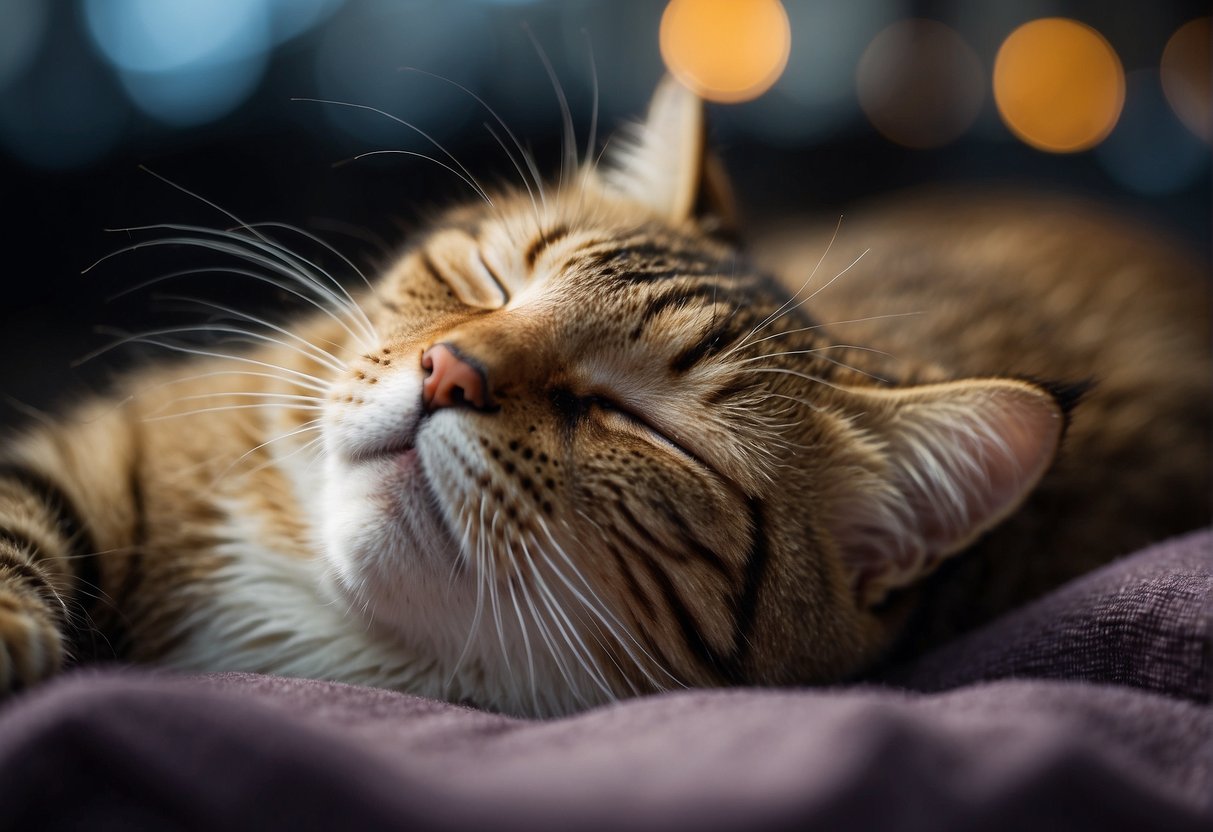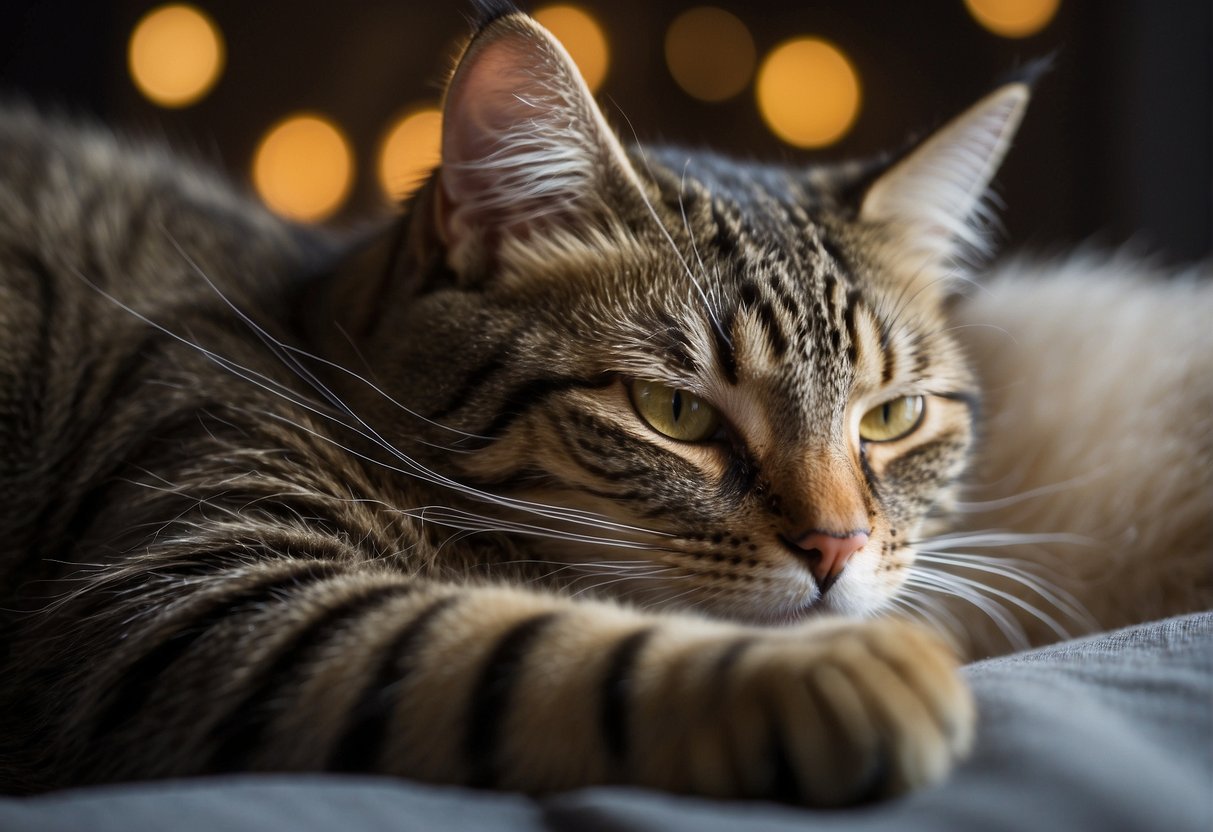Cats twitch in their sleep due to a phase of their sleep cycle similar to the REM (Rapid Eye Movement) stage in humans, where dreaming commonly occurs. During this stage, you might notice your cat exhibiting slight jerks or twitches which can include anything from a subtle paw twitch to a more noticeable full-body jerk.

These involuntary movements are generally no cause for alarm and can vary in intensity and frequency among different cats.
The twitching happens because, during REM sleep, the brain is highly active but messages to the muscles are typically inhibited, causing these spasms.
Still, it’s always a good idea to keep an eye on the frequency and nature of the twitching. If you ever notice anything out of the ordinary, like continuous twitching paired with more worrying signs such as uncontrolled urination or severe muscle spasms, consulting a vet is recommended to rule out any potential issues such as seizures or neurological conditions.
Looking Into Cat Sleep Patterns

When observing your cat’s sleep, you’ll notice distinct patterns and behaviors that speak volumes about their overall health and natural instincts.
The Basics of Cat Sleep
Cats are known for their love of sleep, with adult cats averaging 12-16 hours of slumber per day, and kittens and seniors possibly sleeping even more. Your feline friend’s sleep is not continuous; it consists of multiple bouts of slumber, shifting between light and deep sleep.
During the light sleep phase, your cat remains semi-alert to detect threats or opportunities, hence the “catnap” term.
REM Sleep and Cats
The deep sleep phase, particularly REM (Rapid Eye Movement) sleep, is where your cat’s body completely relaxes. It’s in this phase, typically lasting around 10-20% of sleep time, that you might witness your cat’s paws or whiskers twitching.
These twitching movements might be related to your cat’s instincts, such as chasing prey. REM sleep is essential for memory consolidation in cats, which is important for their learning and retention of survival skills.
Common Causes of Twitching in Cats
Cats often twitch in their sleep due to normal sleep patterns such as dreaming, but sometimes it can be linked to health issues ranging from benign muscle spasms to more serious neurological disorders.
Dreaming and Muscle Movements
When your cat is curled up and suddenly starts to twitch, chances are they’re deep in a dream. Much like you, your cat experiences different sleep stages, and the rapid eye movement (REM) stage is when dreams occur.
During this stage, muscle twitches can happen as their body acts out the dream. It’s common to see their whiskers quiver, paws paddle as if running, and even their ears twitching.
Health and Neurological Disorders
Beyond dreaming, certain health conditions can cause twitching during sleep. Epilepsy, a disorder marked by recurrent seizures, may manifest as twitching when your cat is resting or asleep.
Feline hyperesthesia syndrome, also known as “twitch-skin syndrome” and “rippling skin disorder,” can result in twitches along the back, typically accompanied by more obvious signs of distress or agitation. Accidental toxicity from ingesting something harmful can lead to muscle spasms, too, just like injuries affecting the nervous system might.
Responding to Cat Twitching
Occasional twitching in cats during sleep is typically normal, but it’s important to know when such movements may signal a need for veterinary attention. Pay close attention to the nature of the twitching and your cat’s overall health to help them sleep soundly and safely.
When to Consult a Veterinarian
If your cat’s sleep twitching seems to be seizure-like or excessively frequent, consulting a veterinarian is crucial. Seizures involve involuntary muscle contractions and can have different presentations, ranging from subtle to severe full-body spasms.
Here is a checklist indicating when it might be time to seek professional advice:
- Intensity: If the twitching is violent or accompanied by unusual vocalizations.
- Duration: If the episodes last longer than a few minutes or occur in clusters.
- Consciousness: If your cat seems disoriented or unable to fully wake after twitching.
Home Observation Tips
Before heading to the vet, monitoring your cat’s behavior at home can provide essential clues for diagnosis. Here are some home observation tips:
- Track the Frequency: Note how often the twitching occurs to see if there’s a pattern.
- Document the Context: Observe if stress or specific events trigger your cat’s twitching.
- Look for Other Symptoms: Watch for other signs such as increased drooling, rippling skin, or changes in appetite.
Remember, while sleep twitching in cats often results from normal dreaming or minor muscle relaxations, you know your feline friend best. Trust your instincts when their twitching seems off, and don’t hesitate to reach out for veterinary care to ensure that your cat stays healthy and happy.
Supporting Your Cat’s Health
Ensuring your cat remains healthy often means keeping an eye on their behavior and body movements, even during sleep. When you notice your cat twitching in its sleep, it’s important to understand when this behavior is normal and when it may indicate a health issue.
This understanding can help prevent injuries and manage any underlying conditions that could be influencing your cat’s sleep twitches.
Preventing Injuries and Trauma
Injuries and trauma can sometimes cause itchy skin or noticeable changes in your cat’s behavior and muscle movements. To prevent injuries:
- Always provide a safe sleeping environment, free of potential hazards that could injure your cat during its activated sleep phases.
- Regularly inspect your cat’s play areas to ensure there are no sharp edges or small objects that could cause harm.
Managing Underlying Conditions
Underlying health conditions may contribute to involuntary muscle movements seen in cats twitching during sleep. To manage these conditions:
- Regular Vet Visits: Schedule annual check-ups with your vet to monitor your cat’s overall health, including muscle tone and skin condition.
- Flea Control: Address itchy skin caused by fleas by using recommended flea treatments to keep these pests at bay.

My name is James, and welcome to FAQCats!
Along with our team of cat owners, expert pet enthusiasts, and pet professionals, we aim to write engaging helpful, engaging content about cats. At FAQCats we strive to provide content that’s accurate and fun to read. Our team writes about everything related to cats; even the most complex of topics. Through extensive research and caring for our own fur-pals, we’re able to provide something cat owners worldwide will love. Have a look around, and leave us feedback anytime!

